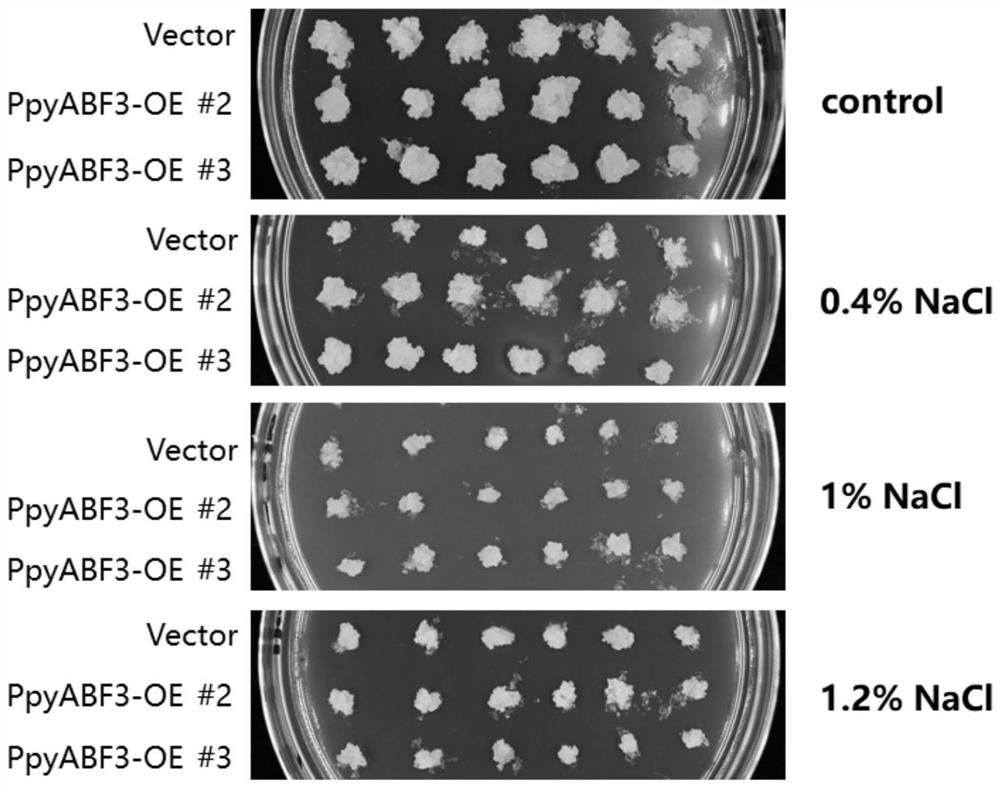Application of PpyABF3 gene in regulating and controlling salt stress resistance of pear tree
A salt stress, pear tree technology, applied in the field of genetic engineering, can solve the problems of unsatisfactory effect, change the salt resistance performance of pear group, not easy to popularize, etc., and achieve the effect of enhancing the salt stress resistance performance.
- Summary
- Abstract
- Description
- Claims
- Application Information
AI Technical Summary
Problems solved by technology
Method used
Image
Examples
Embodiment 1
[0037] Embodiment 1: the cloning of pear PpyABF3 gene
[0038] 1. Extraction of RNA from tissue cultured seedlings of Qiuzi pear
[0039] The total RNA of plant tissue is extracted by CTAB method, and the steps include:
[0040] 1. Reagent preparation:
[0041] (1) CTAB RNA extraction solution (1L, sterilized at 121°C for 45min): 20g CTAB, 20g PVP, 7.3g EDTA, 1g spermidine, 12.1g Tris, 117g NaCl, make up to 1L.
[0042] (2) SSTE (500mL, pH=8.0, sterilized at 121°C for 4min): 29.25g NaCl, 2.5g SDS, 0.6g Tris, 0.15g EDTA, dilute to 500mL.
[0043] (3) 12M LiCl (100mL, sterilized at 121°C, 40min): 50.87g LiCl to 100mL.
[0044] (4) Chloroform: isoamyl alcohol (24:1): 21 mL of isoamyl alcohol was added to 500 ml of chloroform (chloroform).
[0045] 2. Preparation of consumables:
[0046] 1.5mL and 10mL centrifuge tubes, 10μL, 200μL, 1mL and 5mL tips, 150μL drain tubes. Sterilize at 121°C for 45 minutes and prepare for use.
Embodiment 2
[0101] Embodiment 2: Construction and genetic transformation of PpyABF3 gene overexpression vector
[0102] In order to study the function of the PpyABF3 gene, a total of 1296bp fragment including the coding region of the PpyABF3 gene was correctly inserted into the pCAMBIA1301 expression vector.
[0103] According to the upstream and downstream primers used to amplify the gene PpyABF3, the upstream and downstream primers were designed to add restriction sites SpeⅠ and BstEⅡ respectively, and the pCAMBIA1301 plasmid was used as a template for amplification. The ClonExpress II One Step Cloning Kit kit from ClonExpress II One Step Cloning Kit was connected to pCAMBIA1301, transformed into Escherichia coli DH5α, and sequenced in Zhejiang Shangya Biotechnology Co., Ltd. after screening. After the sequencing was correct, the 6×Myc tag was connected to the pCAMBIA1301 vector to construct a new expression vector, so that the target protein and the Myc tag were located in the same cod...
Embodiment 3
[0107] Example 3: PpyABF3 overexpression of pear callus acquisition
[0108] 1. Take wild-type eggplant pear callus in MS solid medium (add 6-BA: 0.5mg L -1 +2,4-D: 1mg L -1 ) cultured for 15-20d. Activate the Agrobacterium strain containing the Myc-PpyABF3 plasmid, centrifuge the bacterial liquid, absorb the MS liquid medium, aspirate the bacterial cell to precipitate to suspension, and place it on a shaker at a speed of 200rpm for 40min-1h, so that the final concentration is OD 600 = 0.4. Pick the callus that has grown to a milky white and clear state, mix it with the above bacterial solution, shake it at room temperature for 10 minutes, filter the bacterial solution through a sterile filter cloth, and then use sterile filter paper to absorb excess bacterial solution, and then transfer the callus to a non-resistant cell. MS solid medium (add 6-BA: 0.5mg·L -1 +2,4-D: 1mg L -1 )middle. Under sterile co-cultivation at 25°C in the dark for about 3 days, the callus was take...
PUM
 Login to View More
Login to View More Abstract
Description
Claims
Application Information
 Login to View More
Login to View More - R&D
- Intellectual Property
- Life Sciences
- Materials
- Tech Scout
- Unparalleled Data Quality
- Higher Quality Content
- 60% Fewer Hallucinations
Browse by: Latest US Patents, China's latest patents, Technical Efficacy Thesaurus, Application Domain, Technology Topic, Popular Technical Reports.
© 2025 PatSnap. All rights reserved.Legal|Privacy policy|Modern Slavery Act Transparency Statement|Sitemap|About US| Contact US: help@patsnap.com



